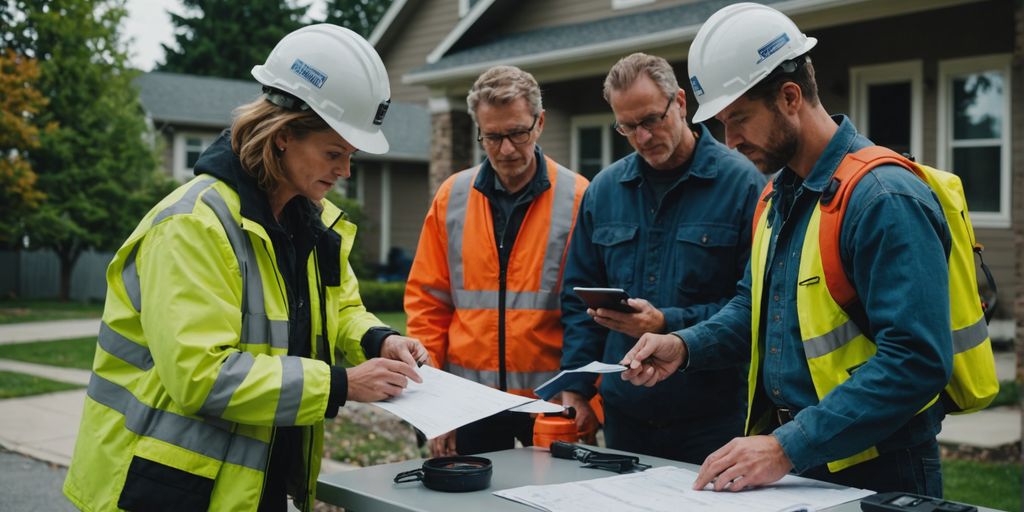Emergencies can strike at any moment, whether you’re at home, work, or out in your neighborhood. While you can’t predict when they’ll happen, you can take steps to improve your preparedness and security. This article will provide you with practical tips and tricks to enhance your emergency security, ensuring that you’re ready to respond effectively when the unexpected occurs.
Key Takeaways
- Understand the potential risks in your environment to better prepare for emergencies.
- Develop a comprehensive emergency plan that includes clear roles and responsibilities.
- Implement an effective communication system to keep everyone informed during a crisis.
- Conduct regular training sessions to ensure everyone knows what to do in an emergency.
- Maintain and regularly inspect emergency equipment to ensure it’s ready when needed.
Understanding Potential Risks
The first step in enhancing emergency procedures is understanding the risks. This entails identifying potential risks and dangers in the job, neighborhood, or home and developing a plan that takes each situation into account.
Developing an Emergency Plan
Creating a solid emergency plan is a key step in ensuring safety during unexpected events. Preparation is critical to surviving a crisis. Don’t wait for a disaster to decide how to respond—learn how to create an emergency management plan.
Implementing an Emergency Communication System
Implementing an effective emergency communication system involves careful planning and clear messaging. Good plans help everyone to be on the same page and will ensure timely responses during emergencies. By considering the unique needs of your organization, you can create a safer environment for everyone.
Conducting Regular Training Sessions
Regular training sessions are essential to ensure everyone knows what to do in an emergency. Effective safety training is crucial for a safe workplace. Here are some key aspects to consider:
Scheduling Drills and Simulations
Regularly scheduled fire drills and other simulations are essential to reinforce safety protocols and keep everyone prepared. Ideally, these drills should be conducted periodically to ensure readiness.
Providing First Aid Training
First aid training is a must for all employees. It equips them with the skills needed to handle medical emergencies until professional help arrives. This training should be refreshed regularly to keep everyone up-to-date.
Educating on Evacuation Procedures
Employees should be well-versed in evacuation procedures. Conducting regular drills helps them understand the steps to take during an emergency, ensuring a smooth and efficient evacuation process.
Consistent safety training, including short safety talks and toolbox talks, helps maintain situational and safety awareness. These mini safety meetings are a low-lift way to establish a consistent cadence of learning about safety best practices.
Maintaining Emergency Equipment
Regular inspections are crucial to ensure that emergency equipment is in excellent working condition. Inspect items like fire extinguishers, first aid kits, and emergency lights for any damage or expired components. This process helps in identifying issues before they become serious problems.
It’s important to keep essential supplies well-stocked and up-to-date. Items such as water, food, hygiene products, and sanitation supplies should be readily available. Make sure to replace any expired or damaged items promptly.
Emergency equipment should be easily accessible to everyone. Fire extinguishers should be placed in visible locations, and first aid kits should be within easy reach. Accessibility ensures that in an emergency, the necessary tools are available without delay.
Keeping emergency equipment in top condition can significantly reduce the impact of an emergency. Regular checks and updates are key to effective emergency preparedness.
Building Relationships with Local Emergency Services
Establishing Contact with Authorities
Effective coordination with local authorities and emergency services is essential for a successful emergency response. Start by reaching out to your local police, fire department, and medical services. Attend community meetings and introduce yourself to key personnel. This will help you build a network of contacts who can provide assistance during emergencies.
Participating in Community Safety Programs
Get involved with community emergency response teams (CERT) or similar programs. These groups train residents to prepare, aid, and equip neighbors to deal with emergencies. Find out who in your neighborhood can perform CPR and first aid, or better yet, get trained yourself. Participating in these programs not only enhances your skills but also strengthens community bonds.
Collaborating on Emergency Drills
Work with local authorities to organize and participate in emergency drills. These drills help you understand the protocols and procedures of local emergency services. They also provide an opportunity to practice your own emergency plans in a controlled environment. Regular drills ensure that everyone knows their role and can act quickly and efficiently during a real emergency.
Building strong relationships with local emergency services can significantly improve your community’s resilience and response during emergencies.
Enhancing Physical Security Measures
Installing Surveillance Systems
Surveillance systems are essential for monitoring and recording activities in and around your property. Installing cameras at strategic locations can deter potential intruders and provide valuable evidence if an incident occurs. Ensure that the cameras cover all entry points and high-traffic areas.
Securing Entry Points
Securing entry points is crucial to prevent unauthorized access. Use sturdy doors and windows, and consider installing additional locks or security bars. Reinforce doors with deadbolts and ensure that all windows have secure latches. Regularly check these entry points for any signs of wear or tampering.
Implementing Access Control Systems
Access control systems help manage who can enter your property and when. These systems can include key cards, biometric scanners, or keypad entry. Implementing access control can significantly reduce the risk of unauthorized access and improve overall security. Make sure to regularly update access permissions and monitor the system for any irregularities.
Promoting Personal Safety Awareness
Recognizing Suspicious Behavior
Being aware of your surroundings is crucial for personal safety. Recognizing suspicious behavior can help you avoid potential threats. Look for unusual actions, like someone loitering without a clear purpose or trying to access restricted areas. Trust your instincts and report anything that feels off.
Understanding Personal Protective Equipment
Personal protective equipment (PPE) is essential for staying safe in various situations. Items like gloves, masks, and safety goggles can protect you from harm. Make sure you know how to use PPE correctly and when it’s necessary. Regularly check your equipment to ensure it’s in good condition.
Self-Defense Techniques
Learning self-defense techniques can boost your confidence and help you stay safe. Consider taking a self-defense class to learn basic moves that can protect you in dangerous situations. Practice regularly to keep your skills sharp.
Prioritizing your own safety is an essential step towards overall well-being. By being aware and proactive, you can help deter any potential threats.
Preparing for Natural Disasters
Creating a Disaster Response Plan
When disaster strikes, having a well-thought-out plan can make all the difference. Know what disasters and hazards could affect your area, how to get emergency alerts, and where you would go if you and your family need to evacuate. Make sure everyone in your household understands the plan and knows their role.
Stocking Emergency Kits
An emergency kit is essential for surviving the initial impact of a disaster. Ensure you have a plan in place and prepare a list of items your pet would need, for example: leash. Your kit should include:
- Water and non-perishable food
- First aid supplies
- Flashlights and batteries
- Important documents
- Medications
Understanding Local Warning Systems
Educate yourself on potential disasters in your area. One of the worst things you can do is pretend something like a tornado could never happen to you. Familiarize yourself with local warning systems and know how to receive alerts. This knowledge can give you precious time to act and stay safe.
A little preparation can make a huge difference when it comes to keeping track of loved ones in the event of an emergency, such as a natural disaster.
Improving Mental Health Preparedness
Identifying Signs of Burnout
Recognizing the early signs of burnout is crucial for maintaining mental health. Burnout can lead to serious health issues if not addressed promptly. Look out for symptoms like chronic fatigue, irritability, and a lack of motivation. Encourage open communication so employees feel comfortable discussing their mental state.
Providing Mental Health Resources
Offering mental health resources is essential for a supportive work environment. Provide access to counseling services, mental health hotlines, and self-help materials. Promote employee assistance services and build a culture that addresses the stigma of seeking help for mental health reasons.
Encouraging Open Communication
Creating an environment where open communication is encouraged can significantly improve mental health. Regular check-ins and team meetings can help identify potential red flags related to mental health. Encourage employees to share their feelings and support each other.
When your organization promotes good mental health, you are not only supporting your employees’ well-being; you’re also promoting a safer workplace overall.
Here are some additional strategies to consider:
- Practice gratitude: think about what you’re thankful for – like supportive family.
- Prioritize quality sleep.
- Get moving and exercise regularly.
- Take time for yourself.
- Connect with others.
- Practice mindfulness.
- Seek professional help when needed.
Taking steps to cope with stress can help you feel better. Explore relaxation techniques like deep breathing exercises, guided imagery, and changing your focus of attention.
Ensuring Fire Safety
Installing Smoke Detectors
Smoke detectors are your first line of defense against fires. Ensure your home has working smoke alarms installed. For added safety, place one outside every sleeping area. These alarms can save lives by providing early warnings.
Conducting Fire Drills
Practice regularly: conduct fire drills at least twice a year. Practice different scenarios, including nighttime drills, to ensure everyone can escape quickly. This helps everyone know what to do in case of a real fire.
Maintaining Fire Extinguishers
Fire extinguishers should be placed in obvious locations throughout the workplace. Make sure they are continuously maintained and up to date. Check the expiration date of each fire extinguisher and replace any that are outdated. A tiny incident involving the toaster in the break room can be avoided by having a staff person who’s trained and ready to act promptly.
Make sure that emergency equipment is readily available. Fire extinguishers, for example, should be put in obvious locations throughout the workplace, and first aid kits should be kept in areas that are easily accessible to all personnel.
Evaluating and Updating Security Policies
Regular Policy Reviews
Regularly reviewing your security policies is crucial. This helps identify any weaknesses and ensures compliance with current standards. It’s a good idea to schedule these reviews at least once a year, but some organizations opt for quarterly assessments. This way, you can stay ahead of any potential risks and make necessary adjustments promptly.
Incorporating Feedback from Employees
Your employees are on the front lines and can offer valuable insights. Encourage them to provide feedback on existing policies. This can be done through suggestion forms or regular meetings. By incorporating their input, you can create a more effective and comprehensive security strategy.
Adapting to New Threats
The security landscape is always changing. New threats emerge, and technology evolves. To stay protected, your policies must adapt. Regularly update your security measures to address these changes. This includes implementing new technologies and strategies to counteract emerging risks.
Keeping your security policies up-to-date is essential for effective crisis response and risk management.
Summary Table
| Action Item | Frequency | Purpose |
|---|---|---|
| Policy Reviews | Annually/Quarterly | Identify weaknesses, ensure compliance |
| Employee Feedback | Ongoing | Improve policy effectiveness |
| Update Measures | As needed | Address new threats, adapt to changes |
By following these steps, you can ensure your security policies remain robust and effective.
Conclusion
Emergencies can happen when you least expect them, but being prepared can make all the difference. By following the tips and tricks shared in this article, you can boost your security and ensure that you and your workplace are ready for any situation. Remember, regular training, having the right equipment, and clear communication are key. Stay safe and always be prepared.


